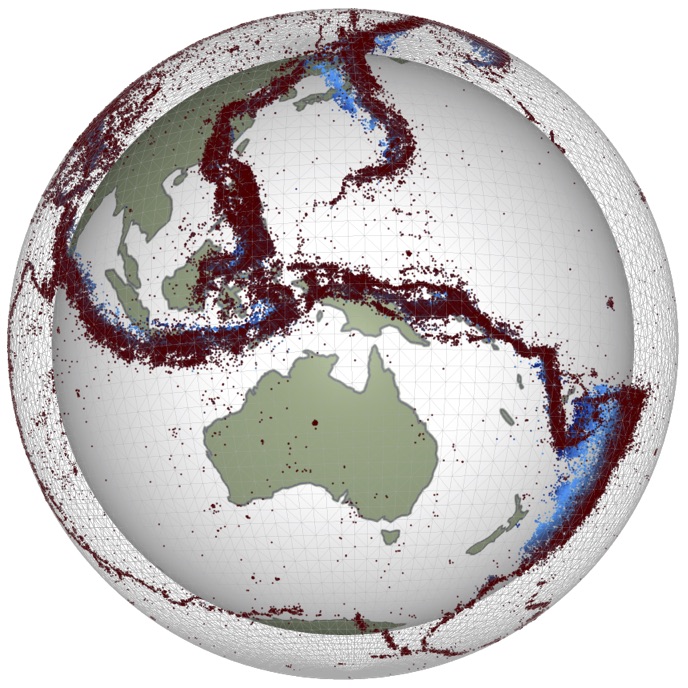Cylindrical 2D Diffusion#
# to fix trame issue
import nest_asyncio
nest_asyncio.apply()
from petsc4py import PETSc
import underworld3 as uw
from underworld3.systems import Poisson
import numpy as np
options = PETSc.Options()
options["dm_plex_check_all"] = None
options["poisson_ksp_rtol"] = 1.0e-3
# options["poisson_ksp_monitor_short"] = None
# options["poisson_nes_type"] = "fas"
options["poisson_snes_converged_reason"] = None
options["poisson_snes_monitor_short"] = None
# options["poisson_snes_view"]=None
options["poisson_snes_rtol"] = 1.0e-3
import os
os.environ["SYMPY_USE_CACHE"] = "no"
# Set some things
k = 1.0
h = 5.0
t_i = 2.0
t_o = 1.0
r_i = 0.5
r_o = 1.0
dim = 2
radius_inner = 0.1
radius_outer = 1.0
import pygmsh
# Generate local mesh.
with pygmsh.occ.Geometry() as geom:
geom.characteristic_length_max = 0.1
if dim == 2:
ndimspherefunc = geom.add_disk
else:
ndimspherefunc = geom.add_ball
ball_outer = ndimspherefunc(
[
0.0,
]
* dim,
radius_outer,
)
if radius_inner > 0.0:
ball_inner = ndimspherefunc(
[
0.0,
]
* dim,
radius_inner,
)
geom.boolean_difference(ball_outer, ball_inner)
pygmesh0 = geom.generate_mesh()
import meshio
mesh = uw.meshing.Annulus(radiusOuter=1.0, radiusInner=0.0, cellSize=0.1)
mesh.dm.view()
t_soln = uw.discretisation.MeshVariable("T", mesh, 1, degree=3)
# check the mesh if in a notebook / serial
if PETSc.Comm.size == 1:
import pyvista as pv
import underworld3.visualisation as vis
pvmesh = vis.mesh_to_pv_mesh(meshbox)
clipped_stack = pvmesh.clip(
origin=(0.0, 0.0, 0.0), normal=(-1, -1, 0), invert=False
)
pl = pv.Plotter()
# pl.add_mesh(pvmesh,'Blue', 'wireframe' )
pl.add_mesh(
pvmesh,
cmap="coolwarm",
edge_color="Black",
show_edges=True,
use_transparency=False,
)
pl.show()
# Create Poisson object
poisson = uw.systems.Poisson(
mesh, u_Field=t_soln, solver_name="poisson", verbose=True
)
poisson.constitutive_model = uw.constitutive_models.DiffusionModel
poisson.k = k
poisson.f = 0.0
bcs_var = uw.discretisation.MeshVariable("bcs", mesh, 1)
import sympy
abs_r = sympy.sqrt(mesh.rvec.dot(mesh.rvec))
bc = sympy.cos(2.0 * mesh.N.y)
with mesh.access(bcs_var):
bcs_var.data[:, 0] = uw.function.evaluate(bc, bcs_var.coords)
poisson.add_dirichlet_bc(bcs_var.sym[0], "Upper", components=0)
poisson.add_dirichlet_bc(-1.0, "Centre", components=0)
poisson.petsc_options.getAll()
# poisson._setup_terms()
poisson.solve()
# check the mesh if in a notebook / serial
if uw.mpi.size == 1:
import pyvista as pv
import underworld3.visualisation as vis
pvmesh = vis.mesh_to_pv_mesh(mesh)
pvmesh.point_data["T"] = uw.function.evaluate(t_soln.fn, mesh.data)
# clipped_stack = pvmesh.clip(origin=(0.001,0.0,0.0), normal=(1, 0, 0), invert=False)
pl = pv.Plotter()
# pl.add_mesh(pvmesh,'Blue', 'wireframe' )
pl.add_mesh(
pvmesh,
cmap="coolwarm",
edge_color="Black",
show_edges=True,
use_transparency=False,
)
pl.show(cpos="xy")
mesh.petsc_save_checkpoint(index=0, meshVars=[t_soln], outputPath='./output/')
## We should try the non linear version of this next ...

